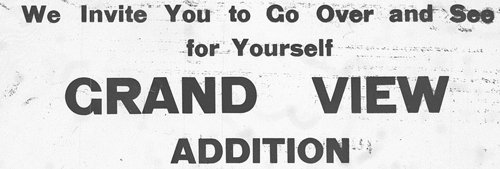A unique way to sell houses was advertised in the Monroe Evening Times by George Bleiler and D. A. Stearns in 1906. The first ad appeared on Sept. 11 and read, “On account of the great number of people in the county who wish to build homes in Monroe and educate their children here, who are unable to get desirable lots at reasonable prices, we have contracted for the land and plotted an addition to Monroe of the best piece of ground within the city limits. The highest piece of ground within the city lies on this addition. The ground gently slopes toward the square, is 10 blocks east of the court house, 4 blocks from school building, [and] 5 block[s] to main sewer. A $5,000 modern residence [is] now building on [a] block adjacent.”
The ad that appeared on Sept. 14 showed by a map that the Grand View addition was between 29th and 30th Avenues and 9th and 13th Streets. In addition, it contained 12 lots on the west side of 29th Avenue and south of 10th Street and 12 lots on 13th Street west of 30th Avenue. The 64 lots were to sell at a uniform price of $250. This addition was to the east and south of the fairgrounds. The ad also said that it was not in a district to be smoked by railroad engines or factories. It also stated, “Lots three blocks away they ask $1,200 for.”
Another ad from the same day stated that they would give $500 for building materials to stimulate building good buildings with lots 8, 26, and 45. There was to be an allotment plan after all 64 lots were sold. Each buyer would receive a card with his name on it for each lot he bought. There would also be another set of cards with the numbers from 1 to 64 on them. The cards with the names would be put into one receptacle and the other cards into another. A selected committee would then draw a card from each receptacle to find out which buyer purchased which lot. No lot was less than 60 feet wide and 120 feet deep and fronted on a full-size street that was 60 feet wide. Each buyer had an equal chance to draw the lots with the $500 worth of building materials.


By Oct. 5, 18 lots had been sold. On Nov. 11, Bleiler & Stearns announced that 43 people had signed contracts for 51 lots, which left only 13 lots left for purchase. The lots were all sold by Nov. 19, but the plat still had to be offered to the city council and some surveying still had to be done. The council did accept the Grandview plat after some discussion. The drawing for lots was done at the armory on Nov. 24. N. B. Treat, Gifford & Mitchell, and Samuel Haman drew the lots with the extra $500.
Frank Millman and Earl Noble had started the erection of houses by April 25 with basement walls laid and wells drilled. A number of houses were expected to be started by later that season. There were prospects that there would be 20 new houses.
I checked city directories to see who lived in that subdivision. By 1922 Mrs. Clara Bleiler, Mrs. Minnie Bleiler, William G. Legler, John McMurtrie, and Carl Ruch lived along what is now between 2801 and 2921 13th Street. Thomas J. Cunningham, Jacob Winkler, and William Dickson lived on what is now 29th Avenue. William Dickson was the only person living on the west side of 30th Avenue in the subdivision. That means there were only nine houses built in this subdivision of 64 lots even 15 after years the lottery was held.
The $5,000 modern residence that was being built in an adjacent block during the early advertisement was located on the south side of 9th Street. It has since been absorbed into the larger fairgrounds, as have the 11 lots on the west side of 29th Avenue that had previously been a portion of the Grand View Addition.
I find this lottery system to be an interesting way to sell lots, even if they are being sold for less than their value. A person could not choose the location of the lot or whether they wanted a corner lot or a lot in the middle of the block. A person would also not be able to purchase two adjacent lots if they wanted room for a garden or just not to have a neighbor next to them. However, it did turn out, by the luck of the draw, Louis Hartwick, Samuel L. Haman, and Charles Mackey did end up with two adjacent lots.
— Matt Figi is a Monroe resident and a local historian. His column will appear periodically on Saturdays in the Times. He can be reached at mfigi@tds.net or at 608-325-6503.



